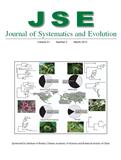Qian-Quan LI, Min-Hui LI, Qing-Jun YUAN,Zhan-Hu CUI,Lu-Qi HUANG, Pei-Gen XIAO
With 84 native species, China is a center of distribution of the genus Salvia (Lamiaceae). These species are mainly distributed in Yunnan and Sichuan provinces (southwestern China), notably the Hengduan Mountain region. Traditionally, the Chinese Salvia has been classified into four subgenera, Salvia, Sclarea, Jungia, and Allagospadonopsis. We tested this classification using molecular phylogenetic analysis of 43 species of Salvia from China, six from Japan, and four introduced species. The nuclear ribosomal internal transcribed spacer region and three chloroplast regions (rbcL, matK, and trnH-psbA) were analyzed by maximum parsimony, maximum likelihood, and Bayesian methods. Our results showed that the Chinese (except Salvia deserta) and Japanese Salvia species formed a well-supported clade; S. deserta from Xinjiang grouped with Salvia officinalis of Europe. In addition, all introduced Salvia species in China were relatively distantly related to the native Chinese Salvia. Our results differed from the subgeneric and section classifications in Flora Reipublicae Popularis Sinicae. We suggested that sections Eusphace and Pleiphace should be united in a new subgenus and that sect. Notiosphace should be removed from subg. Sclarea and form a new subgenus. Our data could not distinguish a boundary between subg. Allagospadonopsis and sect. Drymosphace (subg. Sclarea); the latter should be reduced into the former. Further clarification of the phylogenetic relationships within Salvia and between Salvia and related genera will require broader taxonomic sampling and more molecular markers.

